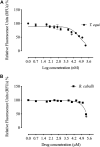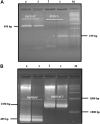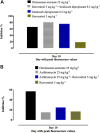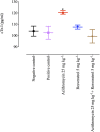Evaluating the inhibitory effect of resveratrol on the multiplication of several Babesia species and Theileria equi on in vitro cultures, and Babesia microti in mice
- PMID: 37324476
- PMCID: PMC10267976
- DOI: 10.3389/fphar.2023.1192999
Evaluating the inhibitory effect of resveratrol on the multiplication of several Babesia species and Theileria equi on in vitro cultures, and Babesia microti in mice
Abstract
Introduction: Histone post-translational modification is one of the most studied factors influencing epigenetic regulation of protozoan parasite gene expression, which is mediated by histone deacetylases (KDACs) and acetyltransferases (KATs). Objective and methods: The present study investigated the role of resveratrol (RVT) as an activator of histone deacetylases in the control of various pathogenic Babesia sp. and Theileria equi in vitro, as well as B. microti infected mice in vivo using fluorescence assay. Its role in mitigating the side effects associated with the widely used antibabesial drugs diminazene aceturate (DA) and azithromycin (AZM) has also been investigated. Results: The in vitro growth of B. bovis, B. bigemina, B. divergens, B. caballi and Theileria equi (T. equi) was significantly inhibited (P < 0.05) by RVT treatments. The estimated IC50 values revealed that RVT has the greatest inhibitory effects on B. bovis growth in vitro, with an IC50 value of 29.51 ± 2.46 µM. Reverse transcription PCR assay showed that such inhibitory activity might be attributed to resveratrol's stimulatory effect on B. bovis KDAC3 (BbKADC3) as well as its inhibitory effect on BbKATS. RVT causes a significant decrease (P < 0.05) in cardiac troponin T (cTnT) levels in heart tissue of B. microti- infected mice, thereby indicating that RVT may play a part in reducing the cardiotoxic effects of AZM. Resveratrol showed an additive effect with imidocarb dipropionate in vivo. Treatment of B. microti-infected mice with a combined 5 mg/kg RVT and 8.5 mg/kg ID resulted in an 81.55% inhibition at day 10 postinoculation (peak of parasitemia). Conclusion: Our data show that RVT is a promising antibabesial pharmacological candidate with therapeutic activities that could overcome the side effects of the currently used anti-Babesia medications.
Keywords: T. equi; azithromycin; babesia; cardiac troponin T; diminazene aceturate; imidocarb dipropionate; resveratrol.
Copyright © 2023 El-Sayed, El-Alfy, Sayed-Ahmed, Mohanta, Alqahtani, Alam, Ahmad, Ali, Igarashi and Rizk.
Conflict of interest statement
The authors declare that the research was conducted in the absence of any commercial or financial relationships that could be construed as a potential conflict of interest.
Figures






References
-
- Aggarwal B. B., Bhardwaj A., Aggarwal R. S., Seeram N. P., Shishodia S., Takada Y. (2004). Role of resveratrol in prevention and therapy of cancer: Preclinical and clinical studies. Anticancer Res. 24, 2783–2840. - PubMed
LinkOut - more resources
Full Text Sources
Research Materials

